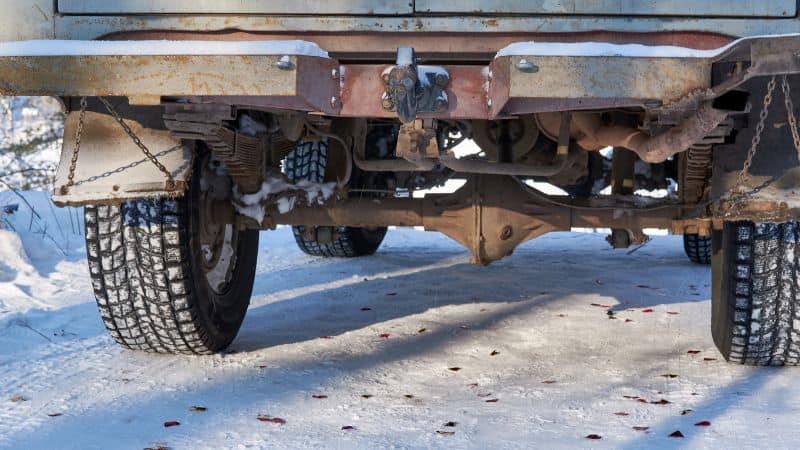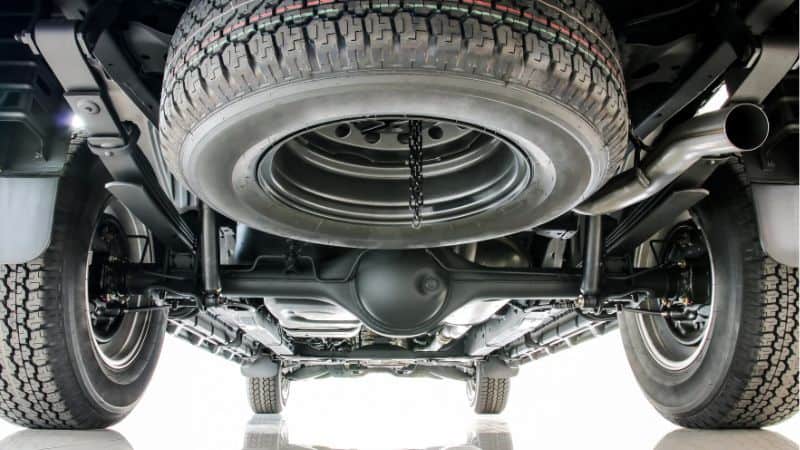Rear drive axles are responsible for transmitting energy to the driving wheels. A driveshaft connects to your engine and rotates the rear axle, turning the car’s wheels.
However, Differentials always work in high pressure and extreme heat conditions. That means their policy is to work under stress. Due to the high operating temperature of axle oil, your axle can cause severe damage.
More severe than average axle temperature can damage your component. That’s why you must take care of its temperature. But you may wonder about exact forward rear drive axle temperatures; don’t think anymore. It’s because here we will discuss this topic with more critical information. Please keep reading:

What Is the Exact Forward Rear Drive Axle Temperature?
Depending on your driving style, your differential operating temperature is 160° to 250°. The average front drive axle temperature is 140 to 190°F, depending on the axle ratio. A 4.11 gear can operate at higher temperatures; axle oil for towing should be 200 to 230°F.
We recommend using a handheld infrared digital thermometer to obtain a more precise temperature reading. You may think this thermometer cost will be high, but it is only between $15 to $50. Use your results in the chart below to determine your oil change interval.
Temperature Reference / Oil Change Interval Chart
It is usual for a new differential to run 250° to 275° during the break-in period. For the first 500 miles, it’s important not to drive or travel long roads as this creates excess heat. At 300°, the differential is considered too hot and must be allowed to cool.
Once broken in, average temperatures for differentials in stock trim and everyday diving are 170°- 220°.
Forward Rear Drive Axle Temperature Sensor:
The rear axle temperature sensor is configured to function and fit the original sensor on the specific vehicle. Due to its quality material features, it provides excellent performance and longer service life.
Most importantly, you can easily install and replace it with your actual sensor. Hence, you must know the location of the forward rear drive axle temperature sensor.
Nonetheless, the temp sensor is located on the axle cover where the red arrow ends. The temperature reading is constant while the axle is running.
Function of Forward Rear Drive Axle Temperature Sensor:
A differential temperature monitors the gear oil temperature in the vehicle’s rear differential. Differential temperature directly affects the performance of the rear axle differential.
A too high temperature in the rear differential can cause your vehicle to wear prematurely. Also, a differential temperature sensor helps detect an over-stressed engine.
The axle temperature sensor will give you highly accurate readings. And it alerts you if your differential temperature is running too low or too high.
Usually, the differential temperature gauge is electronically operated. Besides, it will effectively read your vehicle’s differential temperature from 100°- 250°F with the included ⅛-27 NPT temperature sensor.
The rear drive axle temperature sensor is installed directly behind the differential cover for highly accurate readings. Mainly, this sensor will help you to know the changing period when you’re towing heavy loads.
How do you fix axle oil temperature critical Freightliner Cascadia?
Do you need help with your Freightliner new Cascadia? The first thing you need to do is verify your drive axle oil level. If your oil level is good,
Nevertheless, a check plug is about midway behind the front drive axle. Once the differential has cooled, remove the plug. The oil level should be below the thread or very close.
Usually, If the oil is full, take a handheld thermometer with a laser pointer. Next time that message comes up, check the temperature of both drive axles near or just below the plug.
Unfortunately, you would suspect the cable or sensor if the result is the same. But if it’s truly hot, you need to go inside. The reason is that you should check the pinion bearings to know the source of the heat.
In other words, you can also test by hand, which will be best in different ways. In reality, a non-contact rear axle temperature sensor Freightliner Cascadia will be much better. After doing this test, walk around your rig because you can know how many wheels are broken.
Forward Rear Drive Axle Temperature Symptoms:
The first and most alarming sign is the temperature gauge reading turning red. Basically, this will happen within the first 15 minutes of your car’s engine running. Coolant leaks around the thermostat housing or under the vehicle are the symptoms. Let’s know the more symptoms below:
- Temperature Varies Irregularly
If your differential rear axle temperature varies irregularly, it means there is a problem. That’s why, after noticing any abnormality, it is best to check your temperature with a temperature sensor.
- Normal Operation
When your engine is hot or cool, it is expected to fluctuate slightly if you measure the temperature. The gauge should usually stabilize after the engine reaches its normal operating temperature.
- Fluctuations Of Temperature Gauge
The other symptom of rear axle temperature is a low coolant level. You can know your rear axle has a low coolant level through temperature fluctuations. Due to this low coolant level, your rear differential can overheat. That’s why you should check your coolant level frequently and top it up.
- Thermostat Problems
A faulty thermostat problem is another symptom of the temperature gauge fluctuating. The stuck thermostat does not allow it to reach the optimal operating temperatures. Due to these symptoms, your temperature gauge fluctuates.
- Faulty Cooling System
Faulty cooling systems, like a defective radiator fan or a clogged radiator, can cause the temperature gauge to fluctuate.
- Faulty Temperature Sensor
A temperature sensor malfunctioning is responsible for incorrect readings. So, you can experience temperature gauge fluctuations due to these symptoms.
Important note:
If you notice persistent fluctuations in your axle temperature gauge, you should have it checked by a qualified mechanic.
Why is the Forward Rear Drive Axle Temperature Warning Light On?
The forward rear drive axle temperature warning light is on, which means a problem exists. The meaning of your warning light indicates that your rear axle oil is too hot.
During indication, if you’re riding, slow down your car and stop it at the safe roadside. Wait to cool down your rear axle and light to go out. And once the problem is solved again, you can start your driving.
Unluckily, if overheating continues or the light comes on, call your dealer or service center for assistance. Furthermore, if the temp light is on, the rear axle temp is higher than usual.
Besides this, your temp warning light will be on due to faulty sensors. To resolve this problem, consult your dealer.
Forward Rear Drive Axle Temperature Chevy:
Generally, your Chevy rear drive axle temperature will vary depending on the fluid. Notably, if your fluid is still suitable, your forward rear drive axle Chevy maximum temperature can be 250°.
Most fluids can handle it, and you will be safe. In particular, 300 degrees is the maximum intermittent temperature. Ergo, if you notice an adjusted temperature, then damage will occur. The reason is that your differential truck may not tolerate this temperature.
Rear Axle Oil Temperature Critical:
“Axle Oil Temperature Critical” is a warning message. The message indicates that your automobile’s axle oil temperature level is critical.
That means you should take immediate action to solve the problem. In addition, you can notice this warning sign on the display of the car’s instrument panel or dashboard.
Thankfully, it functions to notify the driver of potential problems with the rear axle system. That’s because if they don’t fix it right away, it could cause you to lose your differential or fail.
FAQ (Frequently Asked Questions)
Q. What is the normal temperature for a rear differential?
Depending on your type of riding, the normal operating temperature of a rear differential is 175° to 250°. Therefore, a handheld infrared digital thermometer can get a more accurate temperature rating. During the new differential break-in period, the temperature averages 250° to 275°.
Q. What is the normal temperature for a front axle?
The normal drive axle temperature of a differential is 175° to 250°. In contrast, if it is significantly out of this range, it is called abnormal temperature. Usually, this is not adequate for your axle.
Q. What is the average axle temperature?
The average axle temperature is 140° to 175°F. Use extreme caution when trying to determine hub temperature. The hub may get too hot to touch during typical bearing operation temperatures.
Final Word
Front and rear differentials run around 190 in cold weather but climb to 220 in the hot 100° plus desert. As we discussed, based on the topic, the average forward rear drive axle temperature is 160° to 250°.
Regular vehicle operating temperatures are 200° to 250° with oversized tires, undersize differentials, or when towing. Remember, breaking in a new gear requires an oil change at 500 miles. Be careful about your rear axle temperature because any abnormality can cause severe damage to your differential.
Finally, we have given the rear drive axle temperature and relative proper information here. We hope that after reading this blog post, you will be helpful.


